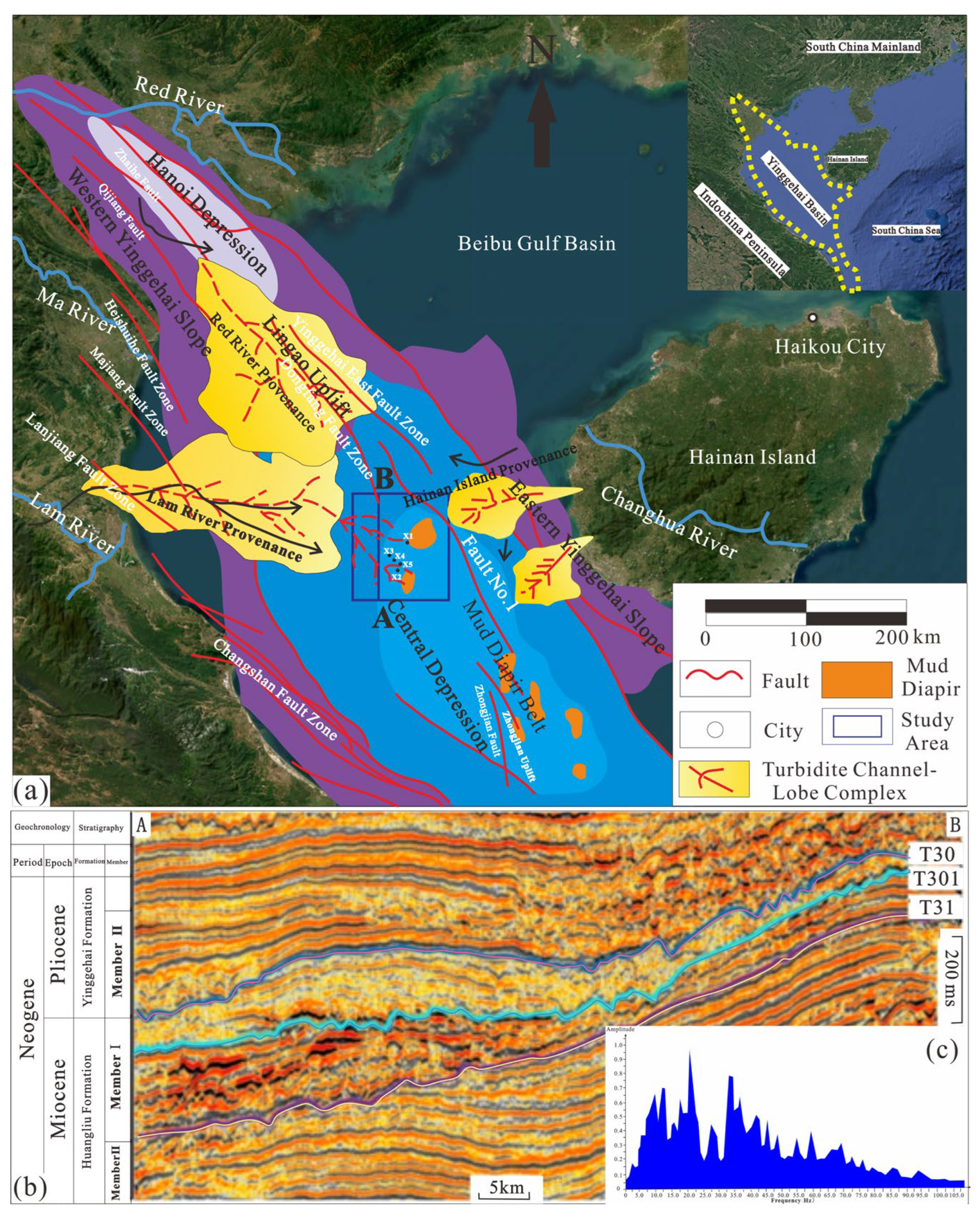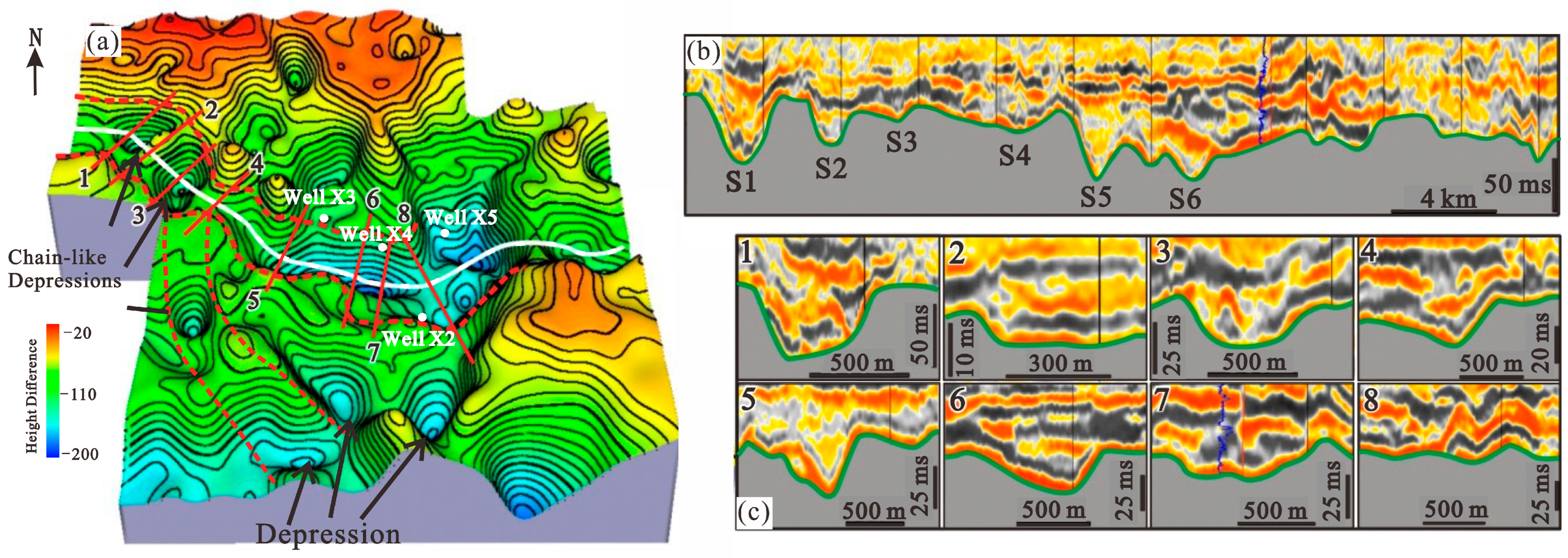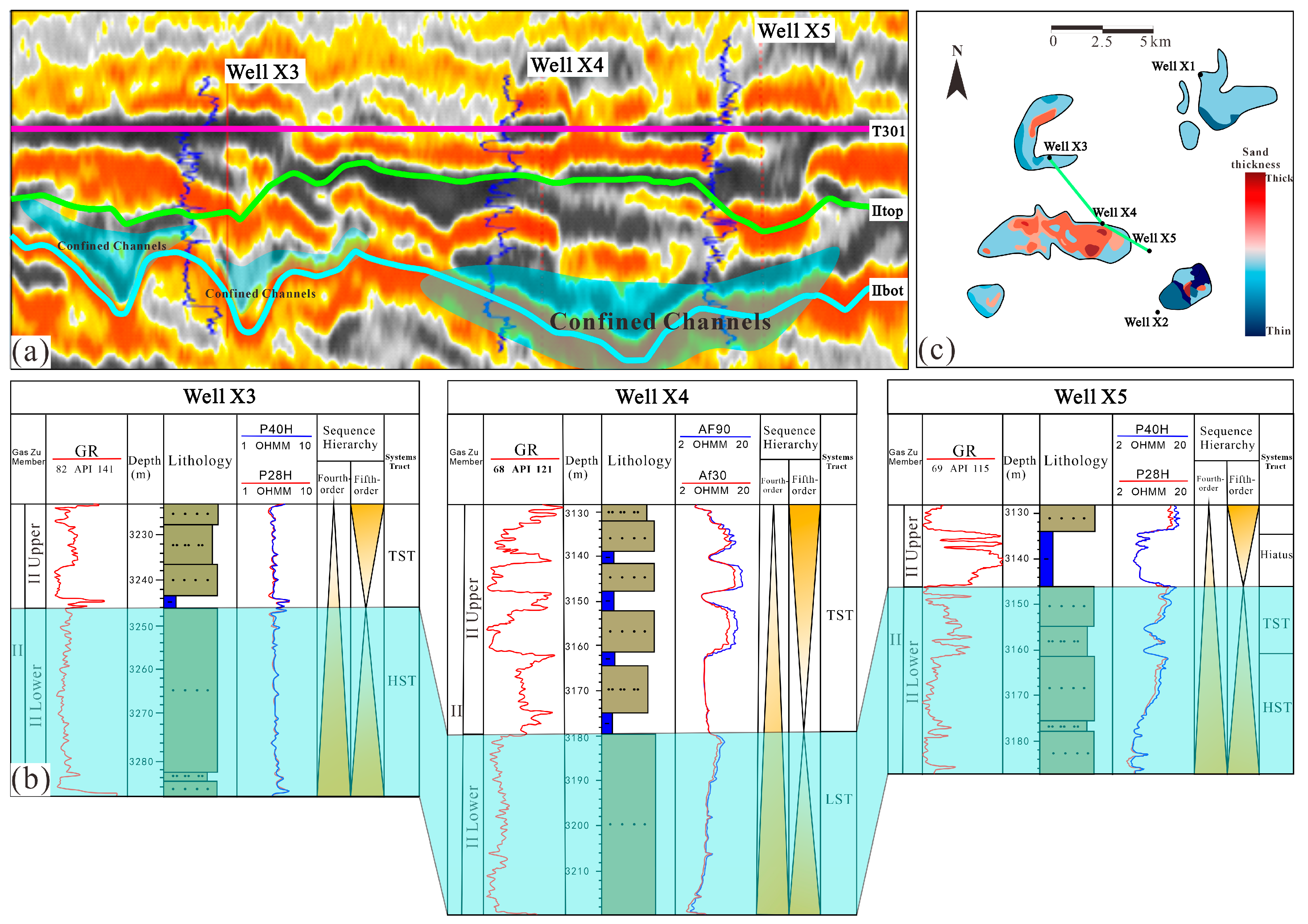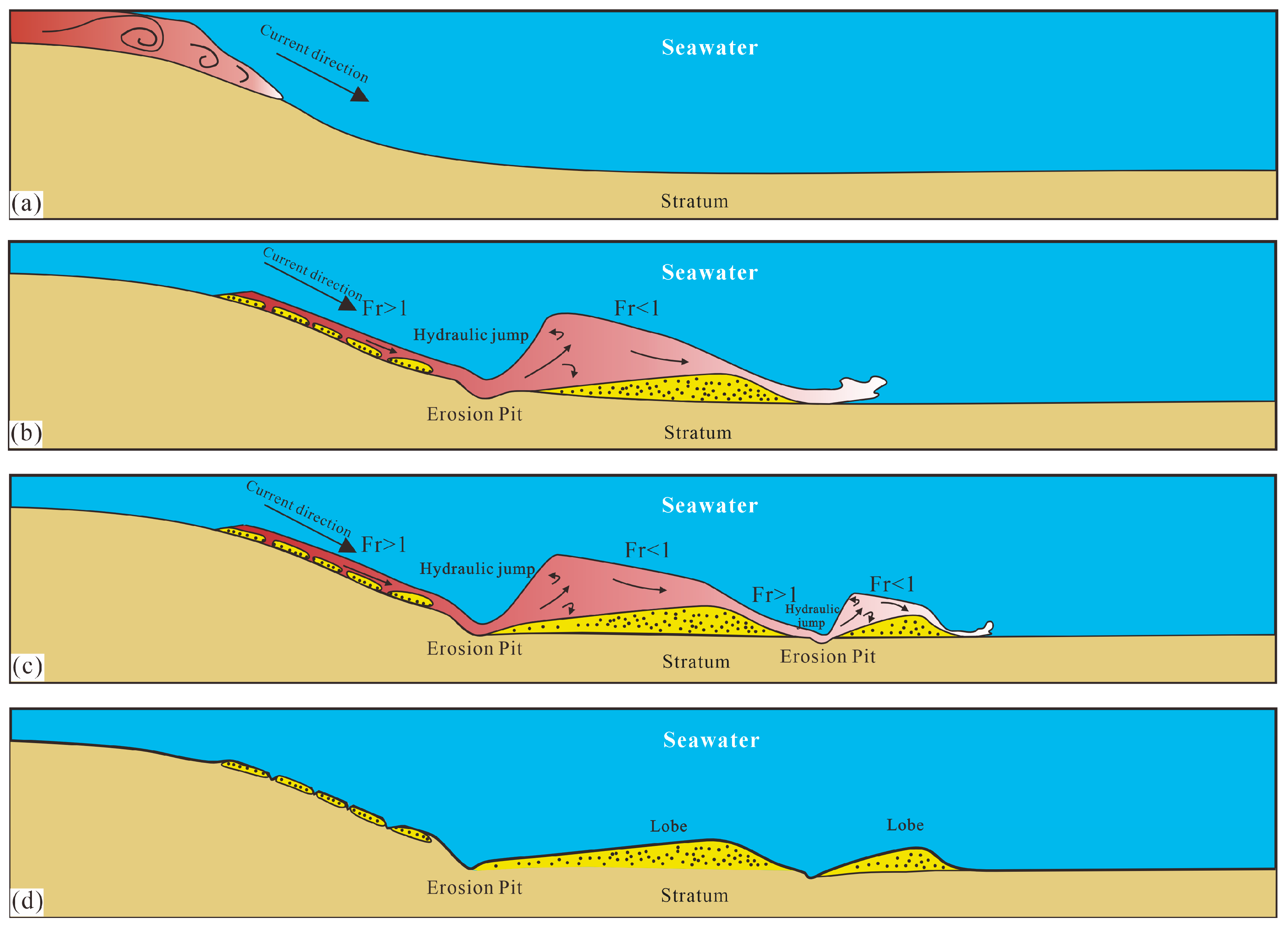The Influence of Seafloor Gradient on Turbidity Current Flow Dynamics and Depositional Response: A Case Study from the Lower Gas-Bearing Interval of Huangliu Formation II, Yinggehai Basin
Abstract
1. Introduction
2. Regional Geological Setting
3. Data Acquisition and Analytical Methods
3.1. Paleotopographic Characteristics
3.2. Depositional System Characterization
3.2.1. Typical Core Facies Characteristics
3.2.2. Log and Seismic Facies Characteristics
3.2.3. Numerical Modeling of Turbidity Current Depositional Processes Under Complex Topographic Conditions
4. Results
5. Discussion
5.1. Turbidity Current Deposition and Sand Body Formation Conditions
5.2. Spatiotemporal Evolution of Sand Bodies
5.3. Control of Turbidity Current Behavior and Sand Body Distribution
5.4. Influence of Slope on Sand Body Deposition
6. Conclusions
Author Contributions
Funding
Data Availability Statement
Conflicts of Interest
References
- Wang, H.; Chen, S.; Jiang, S. Can large gravity flow sediments accumulate and develop in the shallow sea background? Earth Sci. 2022, 47, 3867–3868. [Google Scholar]
- Nasr-Azadani, M.M.; Meiburg, E.; Kneller, B. Mixing dynamics of turbidity currents interacting with complex seafloor topography. Environ. Fluid Mech. 2018, 18, 201–223. [Google Scholar] [CrossRef]
- Middleton, G.V. Sediment Deposition from Turbidity Currents. J. Annu. Rev. Earth Planet Sci. 1993, 21, 89–114. [Google Scholar] [CrossRef]
- Spychala, Y.T.; Hodgson, D.M.; Stevenson, C.J.; Flint, S.S. Aggradational lobe fringes: The influence of subtle intrabasinal seabed topography on sediment gravity flow processes and lobe stacking patterns. Sedimentology 2017, 64, 582–608. [Google Scholar] [CrossRef]
- Wynn, R.B.; Talling, P.J.; Masson, D.G.; Bas, T.P.L.; Stevenson, C.J. The Influence of Subtle Gradient Changes on Deep-Water Gravity Flows: A Case Study from the Moroccan Turbidite System. In Application of the Principles of Seismic Geomorphology to Continental-Slope and Base-of-Slope Systems: Case Studies from SeaFloor and Near-Seafloor Analogues; Prather, B.E., Deptuck, M.E., Mohrig, D.C., van Hoorn, B., Wynn, R.B., Eds.; SEPM Society for Sedimentary Geology: Tulsa, OK, USA, 2012; Volume 99, pp. 371–383. [Google Scholar]
- Nasr-Azadani, M.M.; Meiburg, E. Turbidity currents interacting with three-dimensional seafloor topography. Fluid Mech. 2014, 745, 409–443. [Google Scholar] [CrossRef]
- Straub, K.M.; Mohrig, D.; Mcelroy, B.; Buttles, J.; Pirmez, C. Interactions between turbidity currents and topography in aggrading sinuous submarine channels: A laboratory study. Geol. Soc. Am. Bull. 2008, 120, 368–385. [Google Scholar] [CrossRef]
- Deng, T.D. Sedimentary Simulation Experiment of Huangliu Formation in Dongfang Gas Field Group, Yinggehai Basin. Master’s Thesis, Yangtze University, Jingzhou, China, 2018. [Google Scholar]
- Jiang, P.; Li, M.J.; Zhou, W.; Li, M. Confined-unconfined lobe architecture and evolution of Huangliu Formation Unit 1 in Yinggehai Basin. J. Prog. Geophys. 2019, 34, 2451–2458. [Google Scholar]
- Meiburg, E.; Kneller, B. Turbidity Currents and Their Deposits. J. Annu. Rev. Fluid Mech. 2009, 42, 135–156. [Google Scholar] [CrossRef]
- Tian, D.; Jiang, T. The current situation and Prospect of sedimentary dynamics in deep water channels. Acta Sedimentol. Sin. 2024, 42, 1107–1127. [Google Scholar]
- Dang, Y.Y. Seismic sedimentological study of a section of submarine fan in the Huangliu Formation, Eastern Yinggehai Basin. Bull. Geol. Sci. Technol. 2023, 42, 118–128. [Google Scholar]
- Zhong, Z.H.; Zhang, Y.C.; He, X.H.; Xu, T.; Ren, J.Y.; Liu, X.Y.; Ling, T.; Han, G.M. Sequence stacking patterns and internal architecture of submarine fans in Huangliu Formation, Dongfang area, Yinggehai Basin. Mar. Geol. Quat. Geol. 2015, 35, 91–99. [Google Scholar]
- Kostic, S. Modeling of submarine cyclic steps: Controls on their formation, migration, and architecture. Geosphere 2011, 7, 294–304. [Google Scholar] [CrossRef]
- Zhong, G.; Cartigny, M.J.B.; Kuang, Z.; Wang, L. Cyclic steps along the South Taiwan Shoal and West Penghu submarine canyons on the northeastern continental slope of the South China Sea. Geol. Soc. Am. Bull. 2015, 127, 804–824. [Google Scholar] [CrossRef]
- Cao, Y.C.; Yang, T.; Wang, Y.Z.; Li, W.Q. Formation, evolution and sedimentary characteristics of supercritical sediment gravity-flow. Acta Pet. Sin. 2017, 38, 607–621. [Google Scholar]
- Huang, Y.T.; Yao, G.Q.; Zhou, F.D. Provenance Analysis of Shallow Marine Gravity Flow Sandbodies and Its Petroleum Geological Significance in Yinggehai Basin. Earth Sci. 2016, 41, 1526–1538. [Google Scholar]
- Wang, Y.Z.; Wang, J.M.; Wu, A.J.; Cao, Y.C.; Wang, S.P.; Li, H.Y.; Xiao, L.L.; Shen, J. Sedimentary Facies and Favorable Exploration Target Prediction under Sequence Constraint of the Second Member of Huangliu Formation in the Eastern Margin of Yinggehai Basin. J. China Univ. Pet. 2025, 49, 22–36. [Google Scholar]
- Li, H.; Yang, Z.Q.; Zhou, W.; He, Y.B.; Wang, Y.; Peng, X.; Li, Y.R.; Lv, X.B. Formation mechanism and reservoir distribution of shallow sea multi-level submarine fans of the Miocene Huangliu Formation in Dongfang 1-1 Gas Field, Yinggehai Basin. Oil Gas Geol. 2023, 44, 429–440. [Google Scholar]
- Li, L.; Zhang, P.; Zou, Y.; Ping, T.Q.; Zhuang, Y.; Wang, X.H. Seismic sedimentary facies of shallow marine in Dongfang X Area, Yinggehai Basin. Mar. Geol. Front. 2019, 35, 31–39. [Google Scholar]
- Zhu, S.P.; Zhang, C.; Zhou, W.; Meng, D.; Tang, X.Y. Evaluation and Prediction of Reservoir Quality for Shallow Marine Gravity-Flow Low-Permeability Fine-Grained Sandstone: A Case Study of the First Member of Huangliu Formation in Dongfang A Area, Yinggehai Basin. Mar. Geol. Front. 2025, 41, 1–13. [Google Scholar]
- Yue, S.F.; Zhang, H.; Qin, L.J.; Yang, Z.Q.; Qi, Z.; Wang, Y.B. Sandy Debris Flow Sedimentary Model of the First Member of Huangliu Formation in Dongfang Area, Yinggehai Basin. Pet. Geol. Dev. Daqing 2020, 39, 9–18. [Google Scholar]
- Wang, Z.; Xian, B.; Liu, J.; Fan, C.; Liu, J. Large-Scale Turbidite Systems of a Semi-Enclosed Shelf Sea: The Upper Miocene of Eastern Yinggehai Basin, South China Sea. Sediment. Geol. 2021, 425, 106006. [Google Scholar] [CrossRef]
- Li, X.; Wang, H.; Yao, G.; Peng, Y.; Ouyang, J.; Zhao, X.; Lan, Z.; Huang, C. Sedimentary features and filling process of the Miocene gravity-driven deposits in Ledong area, Yinggehai Basin, South China Sea. J. Pet. Sci. Eng. 2022, 209, 109886. [Google Scholar] [CrossRef]
- Chen, S. Research on the Sedimentary Facies Types and Development Laws of the Yinger Section of the Dongfang Gas Field in the Yinggehai Basin. Ph.D. Dissertation, Northwest University, Xi’an, China, 2020. [Google Scholar]
- Liu, W.; Yang, X.B.; Zhang, X.P.; Duan, L.; Shao, Y.; Hao, D.F. Gravity flow sedimentary characteristics and controlling factors of the Yellow Stream Formation in the eastern Yinggehai Basin. J. Lithol. Reserv. 2019, 31, 75–82. [Google Scholar]
- Wang, H.; Chen, S.; Gan, H.J.; Liao, J.H.; Sun, M. Research advances and accumulation mechanisms of large-scale turbidite fans in shallow marine settings: A case study of gravity flows in the Huangliu Formation, Yinggehai Basin. Earth Sci. Front. 2015, 22, 21–34. [Google Scholar]
- Zhang, H.L.; Pei, J.X.; Zhang, Y.C.; Jiang, C.Y.; Zhu, J.C.; Ai, N.P.; Hu, Q.W.; Yu, J.F. Characteristics of overpressured reservoirs in the middle-deep Huangliu Formation, Dongfang area, Yinggehai Basin. Pet. Explor. Dev. 2013, 40, 284–293. [Google Scholar] [CrossRef]
- Huang, Y.T.; Wen, L.; Yao, G.Q.; Jiang, P. Sedimentary characteristics of thick fine-grained shallow-marine gravity flow deposits from Huangliu Formation in Dongfang area, Yinggehai Basin, China. J. Acta Pet. Sin. 2018, 39, 290–303. [Google Scholar]
- He, W.J.; Xie, J.Y.; Liu, X.Y.; Li, S.S. Foraminiferal Biostratigraphy and Sedimentary Environment of Well DF1-1-11 in Yinggehai Basin. J. Stratigr. 2011, 35, 81–87. [Google Scholar]
- Li, X.; Fu, L.; Wei, P.; Li, J.F.; Xu, G.; Cao, Q.Q.; Zhong, Y.; Wang, Z.P. Restoration of sedimentary paleogeography and its control on sedimentary system: A case study of the Triassic Baikouquan Formation in Shixi area of Junggar Basin. Lithol. Reserv. 2025, 37, 38–48. [Google Scholar]
- Jiang, G.Z.; Xie, H.; Zhao, Z.X.; Shi, H.C.; Pan, H. Cenozoic tectonic-sedimentary evolution and dynamic mechanism analysis of Yinggehai Basin. Haiyang Xuebao 2023, 12, 45. [Google Scholar]
- Lowe, D.R. Sediment gravity flows, II. Depositional models with special reference to the deposits of high-density turbidity currents. J. Sediment. Petrol. 1982, 52, 279–297. [Google Scholar]
- Bouma, A.H. Sedimentology of Some Flysch Deposits: A Graphic Approach to Facies Interpretation; Elsevier: Amsterdam, The Netherlands, 1962; 168p. [Google Scholar]
- Mutti, E. Turbidite Sandstones; Agip Special Publication; AGIP: Milan, Italy, 1992; 275p. [Google Scholar]
- Farouk, S.; El-Din, A.A.; Shennawy, T.E.; Al-Kahtany, K.; Hu, Y. Integration of seismic and well log data for structural evaluation of the west delta deep marine, egypt: Implications for petrophysical analysis of the messinian abu madi reservoir. Mar. Geophys. Res. 2025, 46, 16. [Google Scholar] [CrossRef]
- Wei, J.; Li, L.; Xu, Y.; Xue, G.; Zhang, Z.; Zhang, G. Characterization and Numerical Modeling of Shallow Marine Turbidite Depositional Systems: A Case Study from the Second Member of the Yinggehai Formation, X Gas Field, Yinggehai Basin. J. Mar. Sci. Eng. 2025, 13, 1107. [Google Scholar] [CrossRef]
- Li, L.; Gong, C.L. Gradual Transition from Net Erosional to Net Depositional Cyclic Steps Along the Submarine Distributary Channel Thalweg in the Rio Muni Basin: A Joint 3-D Seismic and Numerical Approach. J. Geophys. Res. Earth Surf. 2018, 123, 2087–2106. [Google Scholar] [CrossRef]
- Chanson, H. Hydraulics of Open Channel Flow; Elsevier: Amsterdam, The Netherlands, 2004. [Google Scholar]
- Konsoer, K.; Zinger, J.; Parker, G. Bankfull hydraulic geometry of submarine channels created by turbidity currents: Relations between bankfull channel characteristics and formative flow discharge. J. Geophys. Res. Earth Surf. 2013, 118, 216–228. [Google Scholar] [CrossRef]
- Postma, G.; Cartigny, M.J.B. Supercritical and subcritical turbidity currents and their deposits—A synthesis. J. Geol. 2014, 42, 987–990. [Google Scholar] [CrossRef]
- Poiré, A.G.; Lajeunesse, P.; Normandeau, A.; Francus, P.; Nzekwe, O.P. Morphological expression of bedforms formed by supercritical sediment density flows on four fjord-lake deltas of the southeastern Canadian Shield (Eastern Canada). Sedimentology 2016, 63, 2106–2129. [Google Scholar]
- Uh Zapata, M.; Pham Van Bang, D.; Nguyen, K.D. Unstructured Finite-Volume Model of Sediment Scouring due to Wave Impact on Vertical Seawalls. J. Mar. Sci. Eng. 2021, 9, 1440. [Google Scholar] [CrossRef]
- Xie, Y.H.; Wang, Z.F.; Xie, X.N.; Ren, J.Y.; Jiang, T. Patterns of Slope-Break Zone and Their Depositional Models in the Yinggehai Basin. J. Earth Sci. 2004, 5, 569–574. [Google Scholar]
- Zhang, N.; Jiang, T.; Zhang, D.J. The topographic and geomorphic characteristics of the seabed in the Qiongdongnan Basin and their control over deep-water sedimentation. J. Mar. Geol. Quat. Geol. 2012, 32, 27–33. [Google Scholar] [CrossRef]
- Roberts, A.M.; Badley, M.E.; Price, J.D.; Huck, I.W. The structural history of a transtensional basin: Inner Moray Firth, NE Scotland. J. Geol. Soc. 1990, 147, 87–103. [Google Scholar] [CrossRef]
- Prather, B.E.; O’Bynre, C.; Pirmez, C.; Sylvester, Z. Sediment partitioning, continental slopes and base-of-slope systems. Basin Res. 2017, 29, 394–416. [Google Scholar] [CrossRef]
- Sarhan, M.A.; Hseinat, M.A.A.; AlZidaneen, M. Geophysical characterization of Miocene Kareem reservoirs in the Tawila West oil field, offshore southern Gulf of Suez Basin, Egypt. Egypt. J. Pet. 2025, 34, 1. [Google Scholar] [CrossRef]
- Farouk, S.; Saada, S.A.; Fagelnour, M.S.; Arafat, M. Petrophysical and Gas Chromatographic Analysis Integration for Hydrocarbon Identifications in Cretaceous Reservoirs, Azhar Field, Beni Suef Basin, Egypt. J. Pet. 2024, 33, 7. [Google Scholar] [CrossRef]
- Jiang, D.G.; Luo, S.S.; Chen, L.; Dai, R.; Pu, Y.X.; Zhou, Q.A.; Yan, H.G.; Pang, J.L. The distribution law and sedimentary model of fine-grained sedimentary rock facies in the 73 subsection of the Yanchang Formation in the Longdong area: Based on the simulation experiment of water trough deposition. J. Palaeogeogr. 2025, 27, 625–640. [Google Scholar]
- Lu, Y. Experimental Study on the Flow and Deposition of Turbidity Currents on Multiple Slopes. Ph.D. Thesis, Anhui University of Technology, Ma’anshan, China, 2019. [Google Scholar]
- Cheng, L.Y.; Li, L.; Gao, Y.F.; Zhang, W.; Gong, G.C.; Yang, Z.P.; Wang, P. Characteristics and Genesis of the seabed periodic step bottom shape in Lingshui Depression, Qiongdongnan Basin. Mar. Geol. Quat. Geol. 2022, 42, 37–44. [Google Scholar]
- Stevenson, C.J.; Talling, P.J.; Wynn, R.B.; Masson, D.G.; Hunt, J.E.; Frenz, M.; Akhmetzhanhov, A.; Cronin, B. The flows that left no trace: Very large-volume turbidity currents that bypassed sediment through submarine channels without eroding the sea floor. Mar. Pet. Geol. 2013, 41, 186–205. [Google Scholar] [CrossRef]
- Komar, P.D. Hydraulic jumps in turbidity currents. Geol. Soc. Am. Bull. 1971, 82, 1477–1487. [Google Scholar] [CrossRef]
- Hand, B.M.; Middleton, G.V.; Skipper, K. Antidune cross-stratification in a turbidite sequence, Cloridorme Formation, Gaspé, Québec. Sedimentology 1972, 18, 135–138. [Google Scholar] [CrossRef]
- Tan, M.X.; Zhu, X.M.; Liu, W.; Shi, R.S. Morphodynamics of cyclic step bedforms and characteristics of associated sediments. Geol. Rev. 2017, 63, 1512–1522. [Google Scholar]






| W | H | S | Ri | Cfi | U1 | Q1 | Ri | Cfi | U2 | Q2 |
|---|---|---|---|---|---|---|---|---|---|---|
| 1708 | 106 | 0.06 | 0.27 | 0.015 | 4.01 | 726,862 | 0.30 | 0.014 | 2.21 | 400,798 |
| 3334 | 94 | 0.03 | 0.41 | 0.010 | 3.07 | 965,100 | 0.47 | 0.008 | 1.65 | 519,925 |
| 530 | 89 | 0.17 | 0.16 | 0.025 | 4.72 | 221,219 | 0.17 | 0.024 | 2.65 | 124,197 |
| 1297 | 53 | 0.05 | 0.34 | 0.012 | 2.54 | 174,825 | 0.38 | 0.011 | 1.38 | 95,326 |
| 1205 | 118 | 0.10 | 0.21 | 0.019 | 4.75 | 675,210 | 0.23 | 0.018 | 2.64 | 376,116 |
| 1196 | 65 | 0.05 | 0.29 | 0.014 | 3.02 | 234,676 | 0.32 | 0.013 | 1.66 | 128,961 |
| 880 | 77 | 0.09 | 0.23 | 0.018 | 3.72 | 250,753 | 0.25 | 0.017 | 2.06 | 139,344 |
| 763 | 47 | 0.07 | 0.27 | 0.015 | 2.67 | 96,081 | 0.30 | 0.014 | 1.47 | 52,973 |
Disclaimer/Publisher’s Note: The statements, opinions and data contained in all publications are solely those of the individual author(s) and contributor(s) and not of MDPI and/or the editor(s). MDPI and/or the editor(s) disclaim responsibility for any injury to people or property resulting from any ideas, methods, instructions or products referred to in the content. |
© 2025 by the authors. Licensee MDPI, Basel, Switzerland. This article is an open access article distributed under the terms and conditions of the Creative Commons Attribution (CC BY) license (https://creativecommons.org/licenses/by/4.0/).
Share and Cite
Xu, Y.; Li, L.; Zhang, G.; Zhou, W.; Zhang, Z.; Wei, J.; Zhao, X. The Influence of Seafloor Gradient on Turbidity Current Flow Dynamics and Depositional Response: A Case Study from the Lower Gas-Bearing Interval of Huangliu Formation II, Yinggehai Basin. J. Mar. Sci. Eng. 2025, 13, 1616. https://doi.org/10.3390/jmse13091616
Xu Y, Li L, Zhang G, Zhou W, Zhang Z, Wei J, Zhao X. The Influence of Seafloor Gradient on Turbidity Current Flow Dynamics and Depositional Response: A Case Study from the Lower Gas-Bearing Interval of Huangliu Formation II, Yinggehai Basin. Journal of Marine Science and Engineering. 2025; 13(9):1616. https://doi.org/10.3390/jmse13091616
Chicago/Turabian StyleXu, Yong, Lei Li, Guohua Zhang, Wei Zhou, Zhongpo Zhang, Jiaying Wei, and Xing Zhao. 2025. "The Influence of Seafloor Gradient on Turbidity Current Flow Dynamics and Depositional Response: A Case Study from the Lower Gas-Bearing Interval of Huangliu Formation II, Yinggehai Basin" Journal of Marine Science and Engineering 13, no. 9: 1616. https://doi.org/10.3390/jmse13091616
APA StyleXu, Y., Li, L., Zhang, G., Zhou, W., Zhang, Z., Wei, J., & Zhao, X. (2025). The Influence of Seafloor Gradient on Turbidity Current Flow Dynamics and Depositional Response: A Case Study from the Lower Gas-Bearing Interval of Huangliu Formation II, Yinggehai Basin. Journal of Marine Science and Engineering, 13(9), 1616. https://doi.org/10.3390/jmse13091616





